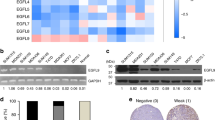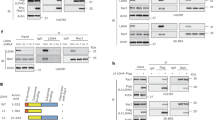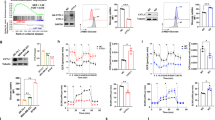Abstract
Metastases remain the major cause of death from cancer. Recent molecular advances have highlighted the importance of metabolic alterations in cancer cells, including the Warburg effect that describes an increased glycolysis in cancer cells. However, how this altered metabolism contributes to tumour metastasis remains elusive. Here, we report that phosphorylation-induced activation of lactate dehydrogenase A (LDHA), an enzyme that catalyses the interconversion of pyruvate and lactate, promotes cancer cell invasion, anoikis resistance and tumour metastasis. We demonstrate that LDHA is phosphorylated at tyrosine 10 by upstream kinases, HER2 and Src. Targeting HER2 or Src attenuated LDH activity as well as invasive potential in head and neck cancer and breast cancer cells. Inhibition of LDH activity by small hairpin ribonucleic acid or expression of phospho-deficient LDHA Y10F sensitized the cancer cells to anoikis induction and resulted in attenuated cell invasion and elevated reactive oxygen species, whereas such phenotypes were reversed by its product lactate or antioxidant N-acetylcysteine, suggesting that Y10 phosphorylation-mediated LDHA activity promotes cancer cell invasion and anoikis resistance through redox homeostasis. In addition, LDHA knockdown or LDHA Y10F rescue expression in human cancer cells resulted in decreased tumour metastasis in xenograft mice. Furthermore, LDHA phosphorylation at Y10 positively correlated with progression of metastatic breast cancer in clinical patient tumour samples. Our findings demonstrate that LDHA phosphorylation and activation provide pro-invasive, anti-anoikis and pro-metastatic advantages to cancer cells, suggesting that Y10 phosphorylation of LDHA may represent a promising therapeutic target and a prognostic marker for metastatic human cancers.
This is a preview of subscription content, access via your institution
Access options
Subscribe to this journal
Receive 50 print issues and online access
$259.00 per year
only $5.18 per issue
Buy this article
- Purchase on Springer Link
- Instant access to full article PDF
Prices may be subject to local taxes which are calculated during checkout







Similar content being viewed by others
References
Fidler IJ . The pathogenesis of cancer metastasis: the ‘seed and soil’ hypothesis revisited. Nat Rev Cancer 2003; 3: 453–458.
Friedl P, Wolf K . Tumour-cell invasion and migration: diversity and escape mechanisms. Nat Rev Cancer 2003; 3: 362–374.
Gupta GP, Massague J . Cancer metastasis: building a framework. Cell 2006; 127: 679–695.
Nguyen DX, Massague J . Genetic determinants of cancer metastasis. Nat Rev Genet 2007; 8: 341–352.
Sahai E . Mechanisms of cancer cell invasion. Curr Opin Genet Dev 2005; 15: 87–96.
Talmadge JE, Fidler IJ . AACR centennial series: the biology of cancer metastasis: historical perspective. Cancer Res 2010; 70: 5649–5669.
Valastyan S, Weinberg RA . Tumor metastasis: molecular insights and evolving paradigms. Cell 2011; 147: 275–292.
Frisch SM, Francis H . Disruption of epithelial cell-matrix interactions induces apoptosis. J Cell Biol 1994; 124: 619–626.
Haddad RI, Shin DM . Recent advances in head and neck cancer. N Engl J Med 2008; 359: 1143–1154.
Brahimi-Horn MC, Chiche J, Pouyssegur J . Hypoxia signalling controls metabolic demand. Curr Opin Cell Biol 2007; 19: 223–229.
Kroemer G, Pouyssegur J . Tumor cell metabolism: cancer’s Achilles’ heel. Cancer Cell 2008; 13: 472–482.
Fan J, Hitosugi T, Chung TW, Xie J, Ge Q, Gu TL et al. Tyrosine phosphorylation of lactate dehydrogenase A is important for NADH/NAD(+) redox homeostasis in cancer cells. Mol Cell Biol 2011; 31: 4938–4950.
Hitosugi T, Kang S, Vander Heiden MG, Chung TW, Elf S, Lythgoe K et al. Tyrosine phosphorylation inhibits PKM2 to promote the Warburg effect and tumor growth. Sci Signal 2009; 2: ra73.
Hitosugi T, Fan J, Chung TW, Lythgoe K, Wang X, Xie J et al. Tyrosine phosphorylation of mitochondrial pyruvate dehydrogenase kinase 1 is important for cancer metabolism. Mol Cell 2011; 44: 864–877.
Hitosugi T, Zhou L, Fan J, Elf S, Zhang L, Xie J et al. Tyr26 phosphorylation of PGAM1 provides a metabolic advantage to tumours by stabilizing the active conformation. Nat Commun 2013; 4: 1790.
Bui T, Thompson CB . Cancer’s sweet tooth. Cancer Cell 2006; 9: 419–420.
Fantin VR, St-Pierre J, Leder P . Attenuation of LDH-A expression uncovers a link between glycolysis, mitochondrial physiology, and tumor maintenance. Cancer Cell 2006; 9: 425–434.
Gao S, Tu DN, Li H, Jiang JX, Cao X, You JB et al. Pharmacological or genetic inhibition of LDHA reverses tumor progression of pediatric osteosarcoma. Biomed Pharmacother 2016; 81: 388–393.
Li J, Zhu S, Tong J, Hao H, Yang J, Liu Z et al. Suppression of lactate dehydrogenase A compromises tumor progression by downregulation of the Warburg effect in glioblastoma. Neuroreport 2016; 27: 110–115.
Miao P, Sheng S, Sun X, Liu J, Huang G . Lactate dehydrogenase A in cancer: a promising target for diagnosis and therapy. IUBMB Life 2013; 65: 904–910.
Xian ZY, Liu JM, Chen QK, Chen HZ, Ye CJ, Xue J et al. Inhibition of LDHA suppresses tumor progression in prostate cancer. Tumour Biol 2015; 36: 8093–8100.
Xie H, Hanai J, Ren JG, Kats L, Burgess K, Bhargava P et al. Targeting lactate dehydrogenase-a inhibits tumorigenesis and tumor progression in mouse models of lung cancer and impacts tumor-initiating cells. Cell Metab 2014; 19: 795–809.
Rizwan A, Serganova I, Khanin R, Karabeber H, Ni X, Thakur S et al. Relationships between LDH-A, lactate, and metastases in 4T1 breast tumors. Clin Cancer Res 2013; 19: 5158–5169.
Sheng SL, Liu JJ, Dai YH, Sun XG, Xiong XP, Huang G . Knockdown of lactate dehydrogenase A suppresses tumor growth and metastasis of human hepatocellular carcinoma. FEBS J 2012; 279: 3898–3910.
Le A, Cooper CR, Gouw AM, Dinavahi R, Maitra A, Deck LM et al. Inhibition of lactate dehydrogenase A induces oxidative stress and inhibits tumor progression. Proc Natl Acad Sci USA 2010; 107: 2037–2042.
Doherty JR, Cleveland JL . Targeting lactate metabolism for cancer therapeutics. J Clin Invest 2013; 123: 3685–3692.
Granchi C, Roy S, Giacomelli C, Macchia M, Tuccinardi T, Martinelli A et al. Discovery of N-hydroxyindole-based inhibitors of human lactate dehydrogenase isoform A (LDH-A) as starvation agents against cancer cells. J Med Chem 2011; 54: 1599–1612.
Yu Y, Deck JA, Hunsaker LA, Deck LM, Royer RE, Goldberg E et al. Selective active site inhibitors of human lactate dehydrogenases A4, B4, and C4. Biochem Pharmacol 2001; 62: 81–89.
Kang Y, Siegel PM, Shu W, Drobnjak M, Kakonen SM, Cordon-Cardo C et al. A multigenic program mediating breast cancer metastasis to bone. Cancer Cell 2003; 3: 537–549.
Zhao M, Sano D, Pickering CR, Jasser SA, Henderson YC, Clayman GL et al. Assembly and initial characterization of a panel of 85 genomically validated cell lines from diverse head and neck tumor sites. Clin Cancer Res 2011; 17: 7248–7264.
Birkeland AC, Yanik M, Tillman BN, Scott MV, Foltin SK, Mann JE et al. Identification of targetable HER2 aberrations in head and neck squamous cell carcinoma. JAMA Otolaryngol Head Neck Surg 2016; 142: 559–567.
Mandal M, Myers JN, Lippman SM, Johnson FM, Williams MD, Rayala S et al. Epithelial to mesenchymal transition in head and neck squamous carcinoma: association of Src activation with E-cadherin down-regulation, vimentin expression, and aggressive tumor features. Cancer 2008; 112: 2088–2100.
Stabile LP, He G, Lui VW, Thomas S, Henry C, Gubish CT et al. c-Src activation mediates erlotinib resistance in head and neck cancer by stimulating c-Met. Clin Cancer Res 2013; 19: 380–392.
Bonuccelli G, Tsirigos A, Whitaker-Menezes D, Pavlides S, Pestell RG, Chiavarina B et al. Ketones and lactate ‘fuel’ tumor growth and metastasis: evidence that epithelial cancer cells use oxidative mitochondrial metabolism. Cell Cycle 2010; 9: 3506–3514.
Zhao D, Zou SW, Liu Y, Zhou X, Mo Y, Wang P et al. Lysine-5 acetylation negatively regulates lactate dehydrogenase A and is decreased in pancreatic cancer. Cancer Cell 2013; 23: 464–476.
Beckert S, Farrahi F, Aslam RS, Scheuenstuhl H, Konigsrainer A, Hussain MZ et al. Lactate stimulates endothelial cell migration. Wound Reoaur Regen 2006; 14: 321–324.
Baumann F, Leukel P, Doerfelt A, Beier CP, Dettmer K, Oefner PJ et al. Lactate promotes glioma migration by TGF-beta2-dependent regulation of matrix metalloproteinase-2. Neuro-oncology 2009; 11: 368–380.
Stern R . Hyaluronidases in cancer biology. Sem Cancer Biol 2008; 18: 275–280.
Walenta S, Mueller-Klieser WF . Lactate: mirror and motor of tumor malignancy. Semin Radiat Oncol 2004; 14: 267–274.
de Souza JA, Davis DW, Zhang Y, Khattri A, Seiwert TY, Aktolga S et al. A phase II study of lapatinib in recurrent/metastatic squamous cell carcinoma of the head and neck. Clin Cancer Res 2012; 18: 2336–2343.
Fury MG, Baxi S, Shen R, Kelly KW, Lipson BL, Carlson D et al. Phase II study of saracatinib (AZD0530) for patients with recurrent or metastatic head and neck squamous cell carcinoma (HNSCC). Anticancer Res 2011; 31: 249–253.
Puls LN, Eadens M, Messersmith W . Current status of SRC inhibitors in solid tumor malignancies. Oncologist 2011; 16: 566–578.
Kang S, Dong S, Gu TL, Guo A, Cohen MS, Lonial S et al. FGFR3 activates RSK2 to mediate hematopoietic transformation through tyrosine phosphorylation of RSK2 and activation of the MEK/ERK pathway. Cancer Cell 2007; 12: 201–214.
Kang Y, He W, Tulley S, Gupta GP, Serganova I, Chen CR et al. Breast cancer bone metastasis mediated by the Smad tumor suppressor pathway. Proc Natl Acad Sci USA 2005; 102: 13909–13914.
Ponomarev V, Doubrovin M, Serganova I, Vider J, Shavrin A, Beresten T et al. A novel triple-modality reporter gene for whole-body fluorescent, bioluminescent, and nuclear noninvasive imaging. Eur J Nucl Med Mol Imaging 2004; 31: 740–751.
Kang S, Elf S, Lythgoe K, Hitosugi T, Taunton J, Zhou W et al. p90 ribosomal S6 kinase 2 promotes invasion and metastasis of human head and neck squamous cell carcinoma cells. J Clin Invest 2010; 120: 1165–1177.
Zhang X, Liu Y, Gilcrease MZ, Yuan XH, Clayman GL, Adler-Storthz K et al. A lymph node metastatic mouse model reveals alterations of metastasis-related gene expression in metastatic human oral carcinoma sublines selected from a poorly metastatic parental cell line. Cancer 2002; 95: 1663–1672.
Li D, Jin L, Alesi GN, Kim YM, Fan J, Seo JH et al. The prometastatic ribosomal S6 kinase 2-cAMP response element-binding protein (RSK2-CREB) signaling pathway up-regulates the actin-binding protein fascin-1 to promote tumor metastasis. J Biol Chem 2013; 288: 32528–32538.
Jin L, Li D, Lee JS, Elf S, Alesi GN, Fan J et al. p90 RSK2 mediates antianoikis signals by both transcription-dependent and -independent mechanisms. Mol Cell Biol 2013; 33: 2574–2585.
Alesi GN, Jin L, Li D, Magliocca KR, Kang Y, Chen ZG et al. RSK2 signals through stathmin to promote microtubule dynamics and tumor metastasis. Oncogene 2016; 35: 5412–5421.
Jin L, Li D, Alesi GN, Fan J, Kang HB, Lu Z et al. Glutamate dehydrogenase 1 signals through antioxidant glutathione peroxidase 1 to regulate redox homeostasis and tumor growth. Cancer Cell 2015; 27: 257–270.
Acknowledgements
We thank Dr Anthea Hammond for editing the manuscript. We acknowledge the Winship shared resources facilities. This work was supported by NIH grants R01 CA175316 (Sumin Kang), F31 CA183365 (Gina N. Alesi), ACS grant RSG-11-08101 (Sumin Kang) and Pilot Grant-2015/Winship Cancer Institute, Emory University. Gina N. Alesi is an NIH pre-doctoral fellow. Sumin Kang is an American Cancer Society Basic Research Scholar, a Robbins Scholar, and a Georgia Cancer Coalition Scholar. Grant Support: This work was supported by NIH grants R01 CA175316 (Sumin Kang), F31 CA183365 (Gina N. Alesi), and ACS grant RSG-11-08101 (Sumin Kang).
Author contributions
YK, DMS, ZGC and FRK provided critical reagents. KRM conducted histopathological analysis. JF performed crosslinking assay and LDH activity assay. LJ, JC, GNA and DL conducted the other experiments. SK and LJ were responsible for the study design and wrote the paper.
Author information
Authors and Affiliations
Corresponding author
Ethics declarations
Competing interests
The authors declare no conflict of interest.
Additional information
Supplementary Information accompanies this paper on the Oncogene website
Supplementary information
Rights and permissions
About this article
Cite this article
Jin, L., Chun, J., Pan, C. et al. Phosphorylation-mediated activation of LDHA promotes cancer cell invasion and tumour metastasis. Oncogene 36, 3797–3806 (2017). https://doi.org/10.1038/onc.2017.6
Received:
Revised:
Accepted:
Published:
Issue Date:
DOI: https://doi.org/10.1038/onc.2017.6
This article is cited by
-
Anoikis related genes may be novel markers associated with prognosis for ovarian cancer
Scientific Reports (2024)
-
Lactate dehydrogenase A promotes nasopharyngeal carcinoma progression through the TAK1/NF-κB Axis
Molecular Biology Reports (2024)
-
A glimpse into novel acylations and their emerging role in regulating cancer metastasis
Cellular and Molecular Life Sciences (2024)
-
Development of a prognostic model to predict BLCA based on anoikis-related gene signature: preliminary findings
BMC Urology (2023)
-
A novel tyrosine tRNA-derived fragment, tRFTyr, induces oncogenesis and lactate accumulation in LSCC by interacting with LDHA
Cellular & Molecular Biology Letters (2023)



